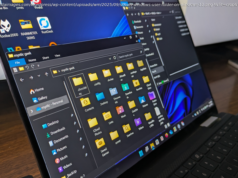Everything you need to know about the Core i9-9900K, including performance, price, cooling, and overclocking.
The AMD versus Intel CPU wars have been going on for decades. Intel hasn’t relinquished the crown for the best consumer processor since it launched the Core 2 Duo line in mid-2006, reclaiming it from AMD’s Athlon 64 X2 line, and for nearly a decade after it held a significant performance lead. But that performance always came with a price, both on the processors as well as the motherboards and chipsets.
Intel Core i9-9900K Specs
8-cores/16-threads
Turbo clock: 5.0GHz
Base clock: 3.6GHz
L3 cache: 16MB
1k pricing: $488
When AMD’s Ryzen processors arrived in 2017, they brought much-needed competition to the CPU market, with clear wins in multi-threaded benchmarks. Intel’s ‚enthusiast‘ parts were still faster, but few users need more than an 8-core processor, and the jump in price for the X99 (and later X299) platform was steep. Intel’s response last year was to release its first 6-core parts for the ‚mainstream‘ platform, the Coffee Lake i7-8700K and similar parts.
Earlier this year, AMD rolled out updated Ryzen 2nd Gen parts, with improved clockspeeds and performance. If everything had gone to plan, we’d now be looking at the first batch of Intel’s 10nm Cannon Lake CPUs. But the difficulties in shrinking microchip manufacturing processes that delayed 14nm have become even more significant at 10nm. Mass production of 10nm from Intel is now slated for mid-2019, but Intel needs something to hold us over until then. That brings us to today’s Coffee Lake refresh.
There are some tweaks to the underlying architecture, including hardware fixes for the Spectre variant 3 and Meltdown exploits. But fundamentally, we’re still looking at the same Coffee Lake architecture. To compensate, Intel has made a few other modifications.
First and most obviously, the 9th Gen Core processors introduce 8-core parts to the mix. Core i9-9900K sits at the top of the stack, with an 8-core/16-thread design thanks to Hyper-Threading. It also comes with a shared 16MB L3 cache, scaling in size directly with the core count. Stepping down is the Core i7-9700K that disables Hyper-Threading, leaving it as an 8-core/8-thread chip. Interestingly, for now at least, there are not any 6-core/12-thread processors in the 9th Gen CPU list. Intel may release those in the future, but we’ll have to wait and see.
Second, Intel says it has made further optimizations to its 14nm process, dubbing the new variant 14nm++. Broadwell and Skylake used the original 14nm process, while Kaby Lake and Coffee Lake used 14nm+. Intel didn’t go into too much detail on what has changed with 14nm++ relative to the existing 14nm+, but Intel says it allows for more cores with similar clock frequencies within the same power envelope. And in terms of specs, the new Core i9-9900K has the same 95W TDP as the previous i7-8700K. More on that in a moment.
The third change goes with the second: for the first time since Devil’s Canyon (the i7-4790K update to Haswell), Intel is using a solder TIM (Thermal Interface Material) on the 9th Gen CPUs. Previously, Intel used thermal paste between the CPU die and the heatspreader. Switching to solder increases the thermal conductivity and improves heat dissipation, which leads to lower temperatures—or similar temperatures at higher clockspeeds.
I’ve heard 5.2-5.3GHz on all cores of the i9-9900K should be possible with liquid cooling, and some of that, at least, will be thanks to the use of solder. My own results so far haven’t been quite that impressive, though 5.0-5.1GHz on all eight cores (with a -2 AVX offset) is decent. I would need a more potent cooling solution to go any further.
Let’s talk specifications briefly. Above is the specs table for the three 9th Gen Core K-series processors. The Core i9-9900K has a 95W TDP, the same as the 9700K and 9600K, as well as the previous generation 8700K and plenty of other CPUs. It also has a minimum guaranteed clockspeed of 3.6GHz and a maximum single-core clockspeed of 5.0GHz. Intel no longer officially discloses all-core turbo clocks, and I think that’s largely because motherboard manufacturers don’t fully adhere to the TDP values on enthusiast processors.
In testing many previous generation CPUs, motherboards from ASRock, Asus, Gigabyte, MSI and more tend to be a bit lenient with TDP and multipliers, especially under heavy loads. Take the MSI Z390 MEG Godlike (I just call her ‚Meg‘) that I’m using for my new 9th Gen testbed. Here are the multipliers for the Core i9-9900K when running ’stock‘:
Here are the various ’stock‘ core multipliers on MSI’s Z390 MEG Godlike board.
MSI lets the 9900K hit 5.0GHz on up to 3-core workloads, 4.8GHz for 4-5 core loads, and 4.7GHz for a fully loaded CPU. That’s impressive, but in my testing—using an NZXT Kraken X62 cooler—the CPU peaked at 85C with y-cruncher and heavy AVX workloads, and Cinebench 15 multi-threaded hits a steady 75C. Performance is great, but the X62 is a beefy cooler, and system power draw from the wall for some workloads exceeded 250W.
CPU monitoring tools like MSI Afterburner report a maximum CPU power draw of 150W with Cinebench, and spikes up to 200W with y-cruncher. So much for that 95W TDP. MSI (or Intel) could adhere to a 95W TDP, but it would mean clockspeeds in some workloads would fall much closer to the 3.6GHz base clock that Intel specifies.
Intel is basically letting the motherboard manufacturers have free reign when it comes to enthusiast CPUs and multipliers. I like that approach, and Intel isn’t alone—AMD’s Ryzen 7 2700X can draw close to 150W ’stock‘ in my X470 testbed. But it’s an important point, because you don’t want to try running an 8-core/16-thread CPU at 4.7GHz with an AVX workload while using a cooler that’s only rated for 95W. You’d probably only get thermal throttling, but it’s better to just plan on buying a high-end cooler for the Core i9-9900K.
That brings up another distinction between AMD and Intel CPUs. The Ryzen 7 2700X comes with a Wraith Prism cooler and currently sells for $305. Intel provides the same number of cores and threads with the Core i9-9900K, and you get about 20 percent higher clockspeeds (and slightly better instructions per clock, or IPC), but the CPU alone costs $488, and you should plan on at least $50 if not $100 or more for cooling purposes. That’s $250 to $300 more in total PC cost in practice… but is it worth the price? That depends a lot on what you’re doing on your PC.
The new Z390 testbed in all its glory. Intel Core i9-9900K Test Setup
9th Gen Testbed
MSI Z390 MEG Godlike NZXT Kraken X62 16GB G. Skill TridentZ DDR4-3200 GeForce GTX 1080 Ti FE Samsung 970 Pro 1TB Samsung 860 Pro 2TB NZXT H500
Rosewill Quark 750W
I’ve updated a few parts of my testbed, but I’m using the same graphics card. I also retested gaming performance (again) due to changes in drivers, game patches, motherboard firmware, and Windows 10 updates. I’m using the latest Windows 10 October 2018 update, with the latest versions of all the games. I’m running Nvidia’s 416.34 drivers, with a GTX 1080 Ti Founders Edition.
All games are tested at 1080p ‚ultra‘ quality, which is usually close to maximum quality. This is to emphasize CPU limits in gaming, while still using reasonable settings for the hardware. (Testing at a lower resolution or lower quality settings could allow for more differentiation, but few gamers would run a 1080 Ti at 1080p medium—and a 1060 at 1080p medium should show similar scaling to the 1080 Ti at ultra quality.)
Due to time constraints, I’ve cut the number of games tested to ten, and I’m not including any overclocked gaming results. (Spoiler: the i9-9900K doesn’t overclock very far beyond the stock settings used on the MSI board with the Kraken X62 and would probably only be 1-2 percent faster at best.) Even with one of the fastest graphics cards available, GPU bottlenecks are still present.
For non-gaming tests, I’ve updated to the latest versions of all the software suites. All tests are ‚real-world‘ applications that are publicly available, and these tend to be skewed toward multi-threaded workloads. Cinebench 1T is the only single-core benchmark, and it continues to provide a reasonable look at individual core performance. Intel Core i9-9900K gaming performance
Image 1 of 11
Swipe left/right for additional charts.
Image 2 of 11
Swipe left/right for additional charts.
Image 3 of 11
Swipe left/right for additional charts.
Image 4 of 11
Swipe left/right for additional charts.
Image 5 of 11
Swipe left/right for additional charts.
Image 6 of 11
Swipe left/right for additional charts.
Image 7 of 11
Swipe left/right for additional charts.
Image 8 of 11
Swipe left/right for additional charts.
Image 9 of 11
Swipe left/right for additional charts.
Image 10 of 11
Swipe left/right for additional charts.
Image 11 of 11
Swipe left/right for additional charts.
Image 1 of 11
Swipe left/right for additional charts.
Image 2 of 11
Swipe left/right for additional charts.
Image 3 of 11
Swipe left/right for additional charts.
Image 4 of 11
Swipe left/right for additional charts.
Image 5 of 11
Swipe left/right for additional charts.
Start
United States
USA — software Intel Core i9-9900K is the new champion of the consumer CPU world






